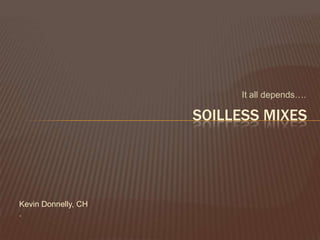Soilless mixes
- 1. It all dependsâĶ. SOILLESS MIXES Kevin Donnelly, CH .
- 2. GROWING MEDIA ï Air ï Water ï Structure ï Nutrient Reservoir
- 3. THE IDEAL MIX ï It all dependsâĶ. ï Fits your growing style ï Produces quality plants with limited management ï Consistent/Predictable ï Cost effective
- 5. MACRO VS. MICROPORES 30% Air 75% Water 45% Water 25% Solids 25% Solids
- 6. CAPILLARY ACTION IN MIX ï Important when sub irrigating containers ï Pores act as a straw and
- 7. ZONE OF SATURATION ï Amount mix will hold at the bottom
- 8. CONTAINER SIZE ï Size and Shape of container can effect water air water relationships ï Look at the force of gravity 45% Air 25% Air 10% Air
- 9. BULK DENSITY/ COMPACTION ï Depending on how it is filled can impact air water relationships ï Compact vs. lightly filed
- 10. SHRINK ï Settling after watering ï Component breakdown ï Out the bottom? ï Shrink from blending
- 11. WHY IT MATTERS ï Overwatering or under watering causes issues ï Pick up method of checking watering status ï If I change the weight of your mix, you will mess up ï Surface may dry up but not underneath ï Knock out pots to check
- 12. WETTING AGENT ï Aids in wetting up mix ï Peat is hydrophobic ï Helps with even watering, ï Not channeling down the sides of the pot ï A good idea for postharvest quality
- 14. PH ï Will effect nutrient availability ï Fluctuates over the course of the crop ï The plant causes pH changes ï Alkalinity of your water is important ï May need to do acid injections ï Buffer capacity of your components ï Lime and Iron Sulfate
- 15. PH
- 16. EC ï AKA soluble salts ï Measure of salt content in solution ï Can be from good salts or bad ï Many use EC as indication of fertility ï Listed in dS/m or ppm (dS/m X 670) ï Dilution method matters!!
- 17. NUTRIENTS ï Minerals/non coated ï dolomite lime ï Iron Sulfate ï Controlled Release Fertilizers (CRF or SRF) ï Encapsulated NPK+ ï Organic Fertilizers ï Often have low analysis and low availability (predictable)
- 18. OTHER MEASURMENTS ï Organic Matter ï CEC ï C:N ï Weed Seed presence ï Wettability ï Moisture content
- 19. TESTING ï What do you test for ï How Often ï How do you test ï Interal testing ï External lab ï What do you do with that information
- 20. SAMPLING ï How you sample may add bias to the test ï Area of pot ï Top 1/3rd ï Middle 1/3rd ï Bottom 1/3rd ï Random sample or targeted sample
- 21. TESTING FOR PHYSICAL PROPERTIES ï Air Porosity ï Field Method ï NCSU Porometer ï Sieve analysis
- 22. TESTING CHEMICAL ï In house ï EC ï pH ï External Lab ï Nutrients ï CEC ï Etc.
- 23. EC ï Method maters ï 1:1 ï 2:1 ï SME ï Pour Thru ï Many use it for managing fert ï If EC reading falls below X, then fertigate
- 24. PH TESTING ï Moving Target ï Can be adjusted 7 6.5 6 5.5 5 4.5 4 1 2 3 4 5 6 7 8 9
- 25. BIG POINT FOR ANY TESTING ï Donât make major changes right after testing starts to correct issues that may be normal ï Need historical values to see what is your norm ï Plants donât read test reports
- 26. BIOLOGICAL ï Mycorrhizae ï Benificial bacteria/fungi ï These can be incorporated into mix ï As well as some pesticides
- 27. Its all about logistics COMPONENTS
- 28. AGGREGATES ï Perlite ï Others ï Vermiculite ï Lava ï Glass ï Sand ï Polystyrene ï Calcined clay ï Rockwool ï Oildri ï LWA
- 29. ORGANIC COMPONENTS ï Peat ï âCompostsâ ï Landscape compost ï Sphagnum ï Manure compost ï Reed Sedge ï Biosolids ï Pine ï Worm Casting ï Rice ï Mushroom âCompostâ ï Coir ï Spent Mushroom Substrate
- 30. NEW PRODUCTS ï Why we need them ï Look for local ï Price ï Cheap ï Availability ï Effective ï Quality ï Sustainability ï These are not replacements
- 31. NEW FRONTIERS ï Whole Tree Substrate ï Corn Cobs ï Miscanthus ï Biochar
- 32. MANAGING RAW COMPONENTS ï These are natural products ï They vary ï They change over time How you manage them maters
































